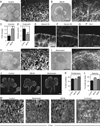Local and global dynamics of the basement membrane during branching morphogenesis require protease activity and actomyosin contractility
- PMID: 25158168
- PMCID: PMC4174355
- DOI: 10.1016/j.ydbio.2014.08.014
Local and global dynamics of the basement membrane during branching morphogenesis require protease activity and actomyosin contractility
Abstract
Many epithelial tissues expand rapidly during embryonic development while remaining surrounded by a basement membrane. Remodeling of the basement membrane is assumed to occur during branching morphogenesis to accommodate epithelial growth, but how such remodeling occurs is not yet clear. We report that the basement membrane is highly dynamic during branching of the salivary gland, exhibiting both local and global remodeling. At the tip of the epithelial end bud, the basement membrane becomes perforated by hundreds of well-defined microscopic holes at regions of rapid expansion. Locally, this results in a distensible, mesh-like basement membrane for controlled epithelial expansion while maintaining tissue integrity. Globally, the basement membrane translocates rearward as a whole, accumulating around the forming secondary ducts, helping to stabilize them during branching. Both local and global dynamics of the basement membrane require protease and myosin II activity. Our findings suggest that the basement membrane is rendered distensible by proteolytic degradation to allow it to be moved and remodeled by cells through actomyosin contractility to support branching morphogenesis.
Keywords: Basement membrane; Branching morphogenesis; Matrix dynamics; Myosin II; Proteases.
Published by Elsevier Inc.
Figures





References
-
- Bernfield M, Banerjee SD. The turnover of basal lamina glycosaminoglycan correlates with epithelial morphogenesis. Dev. Biol. 1982;90:291–305. - PubMed
-
- Bluemink JG, Van Maurik P, Lawson KA. Intimate cell contacts at the epithelial/mesenchymal interface in embryonic mouse lung. J. Ultrastruct. Res. 1976;55:257–270. - PubMed
-
- Candiello J, Cole GJ, Halfter W. Age-dependent changes in the structure, composition and biophysical properties of a human basement membrane. Matrix Biol. 2010;29:402–410. - PubMed
Publication types
MeSH terms
Substances
Grants and funding
LinkOut - more resources
Full Text Sources
Other Literature Sources
Molecular Biology Databases

